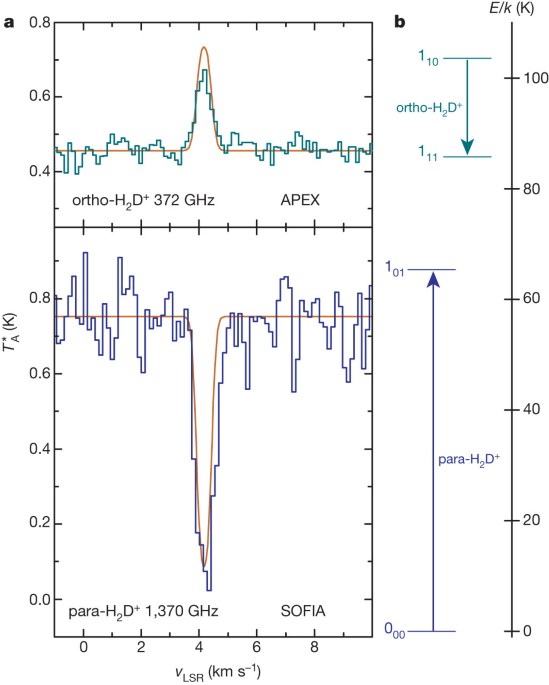
- Select a language for the TTS:
- UK English Female
- UK English Male
- US English Female
- US English Male
- Australian Female
- Australian Male
- Language selected: (auto detect) - EN
Play all audios:
ABSTRACT The age of dense interstellar cloud cores, where stars and planets form, is a crucial parameter in star formation and difficult to measure. Some models predict rapid collapse1,2,
whereas others predict timescales of more than one million years (ref. 3). One possible approach to determining the age is through chemical changes as cloud contraction occurs, in particular
through indirect measurements of the ratio of the two spin isomers (ortho/para) of molecular hydrogen, H2, which decreases monotonically with age4,5,6. This has been done for the dense
cloud core L183, for which the deuterium fractionation of diazenylium (N2H+) was used as a chemical clock to infer7 that the core has contracted rapidly (on a timescale of less than 700,000
years). Among astronomically observable molecules, the spin isomers of the deuterated trihydrogen cation, ortho-H2D+ and para-H2D+, have the most direct chemical connections to H2 (refs 8,
9, 10, 11, 12) and their abundance ratio provides a chemical clock that is sensitive to greater cloud core ages. So far this ratio has not been determined because para-H2D+ is very difficult
to observe. The detection of its rotational ground-state line has only now become possible thanks to accurate measurements of its transition frequency in the laboratory13, and recent
progress in instrumentation technology14,15. Here we report observations of ortho- and para-H2D+ emission and absorption, respectively, from the dense cloud core hosting IRAS 16293-2422 A/B,
a group of nascent solar-type stars (with ages of less than 100,000 years). Using the ortho/para ratio in conjunction with chemical models, we find that the dense core has been chemically
processed for at least one million years. The apparent discrepancy with the earlier N2H+ work7 arises because that chemical clock turns off sooner than the H2D+ clock, but both results imply
that star-forming dense cores have ages of about one million years, rather than 100,000 years. Access through your institution Buy or subscribe This is a preview of subscription content,
access via your institution ACCESS OPTIONS Access through your institution Subscribe to this journal Receive 51 print issues and online access $199.00 per year only $3.90 per issue Learn
more Buy this article * Purchase on SpringerLink * Instant access to full article PDF Buy now Prices may be subject to local taxes which are calculated during checkout ADDITIONAL ACCESS
OPTIONS: * Log in * Learn about institutional subscriptions * Read our FAQs * Contact customer support SIMILAR CONTENT BEING VIEWED BY OTHERS THE 13CO-RICH ATMOSPHERE OF A YOUNG ACCRETING
SUPER-JUPITER Article 14 July 2021 DIURNAL VARIATIONS IN THE STRATOSPHERE OF THE ULTRAHOT GIANT EXOPLANET WASP-121B Article Open access 21 February 2022 15NH3 IN THE ATMOSPHERE OF A COOL
BROWN DWARF Article 06 November 2023 REFERENCES * Ward-Thompson, D. et al. An observational perspective of low-mass dense cores. II: Evolution toward the initial mass function. In
_Protostars and Planets_ V (eds Reipurth, B., Jewitt, A. P. & Keil, K. ) 33–46 (Univ. Arizona Press, 2007) * Hartmann, L., Ballesteros-Paredes, J. & Heitsch, F. Rapid star formation
and global gravitational collapse. _Mon. Not. R. Astron. Soc._ 420, 1457–1461 (2012) ADS Google Scholar * Mouschovias, T. Ch., Tassis, K. & Kunz, M. W. Observational constraints on the
ages of molecular clouds and the star formation timescale: ambipolar-diffusion-controlled or turbulence-induced star formation? _Astrophys. J._ 646, 1043 (2006) ADS CAS Google Scholar *
Flower, D. R. & Watt, G. D. On the ortho-H2/para-H2 ratio in molecular clouds. _Mon. Not. R. Astron. Soc._ 209, 25–31 (1984) ADS CAS Google Scholar * Flower, D. R., Pineau Des Forêts,
G. & Walmsley, C. M. The importance of the ortho:para H2 ratio for the deuteration of molecules during pre-protostellar collapse. _Astron. Astrophys._ 449, 621–629 (2006) ADS CAS
Google Scholar * Pagani, L., Roueff, E. & Lesaffre, P. Ortho-H2 and the age of interstellar dark clouds. _Astrophys. J._ 739, L35 (2011) ADS Google Scholar * Pagani, L. et al.
Ortho-H2 and the age of prestellar cores. _Astron. Astrophys._ 551, A38 (2013) Google Scholar * Pagani, L., Salez, M. & Wennier, P. G. The chemistry of H2D+ in cold clouds. _Astron.
Astrophys._ 258, 479–488 (1992) ADS CAS Google Scholar * Gerlich, D., Herbst, E. & Roueff, E. H3++HD → H2D++H2: low-temperature laboratory measurements and interstellar implications.
_Planet. Space Sci._ 50, 1275–1285 (2002) ADS CAS Google Scholar * Hugo, E., Asvany, O., Harju, J. & Schlemmer, S. Toward understanding of H3+ isotopic and nuclear spin fractionations
in cold space. In _Molecules in Space and Laboratory_ (eds Lemaire, J. L. & Combes, F. ) 119 (S. Diana, 2007) Google Scholar * Hugo, E., Asvany, O. & Schlemmer, S. H3++H2 isotopic
system at low temperatures: microcanonical model and experimental study. _J. Chem. Phys._ 130, 164302 (2009) ADS PubMed Google Scholar * Sipilä, O. et al. Modelling line emision of
deuterated H3+ from prestellar cores. _Astron. Astrophys._ 509, A98 (2010) Google Scholar * Asvany, O. et al. High-resolution rotational spectroscopy in a cold ion trap: H2D+ and D2H+.
_Phys. Rev. Lett._ 100, 233004 (2008) ADS PubMed Google Scholar * Heyminck, S. et al. GREAT: the SOFIA high-frequency heterodyne instrument. _Astron. Astrophys._ 542, L1 (2012) ADS
Google Scholar * Young, E. T. et al. Early science with SOFIA, the Stratospheric Observatory For Infrared Astronomy. _Astrophys. J._ 749, L17 (2012) ADS Google Scholar * Boreiko, R. T.
& Betz, A. L. A search for the rotational transitions of H2D+ at 1370 GHz and H3O+ at 985 GHz. _Astrophys. J._ 405, L39–L42 (1993) ADS CAS Google Scholar * Amano, T. & Hirao, T.
Accurate rest frequencies of submillimeter-wave lines of H2D+ and D2H+. _J. Mol. Spec._ 233, 7 (2005) ADS CAS Google Scholar * Güsten, R. et al. The Atacama Pathfinder EXperiment (APEX)—a
new submillimeter facility for southern skies. _Astron. Astrophys._ 454, L13 (2006) ADS Google Scholar * Wootten, A. The duplicity of IRAS 16293–2422: a protobinary star? _Astrophys. J._
337, 858–864 (1989) ADS CAS Google Scholar * Girart, J. M., Estalella, R., Palau, A., Torrelles, J. M. & Rao, R. On the origin of the molecular outflows in IRAS 16293–2422.
_Astrophys. J._ 780, L11 (2014) ADS Google Scholar * Stark, R. et al. Probing the early stages of low-mass star formation in LDN 1689N: dust and water in IRAS 16293–2422A, B, and E.
_Astrophys. J._ 608, 341–364 (2004) ADS CAS Google Scholar * Crimier, N. et al. The solar type protostar IRAS16293–2422: new constraints on the physical structure. _Astron. Astrophys._
519, A65 (2010) Google Scholar * Keto, E. & Caselli, P. Dynamics and depletion in thermally supercritical starless cores. _Mon. Not. R. Astron. Soc._ 402, 1625 (2010) ADS CAS Google
Scholar * Lombardi, M., Lada, C. J. & Alves, J. Hipparcos distance estimates of the Ophiuchus and the Lupus cloud complexes. _Astron. Astrophys._ 480, 785–792 (2008) ADS Google Scholar
* Sipilä, O., Caselli, P. & Harju, J. HD depletion in starless cores. _Astron. Astrophys._ 554, A92 (2013) ADS Google Scholar * Juvela, M. Non-LTE radiative transfer in clumpy
molecular clouds. _Astron. Astrophys._ 322, 943–961 (1997) ADS Google Scholar * Le Gal, R. et al. Interstellar chemistry of nitrogen hydrides in dark clouds. _Astron. Astrophys._ 562, A83
(2014) Google Scholar * Caselli, P. et al. Survey of ortho-H2D+ (11,0-11,1) in dense cloud cores. _Astron. Astrophys._ 492, 703–718 (2008) ADS CAS Google Scholar * de Graauw, T. et al.
The _Herschel_-Heterodyne Instrument for the Far-Infrared (HIFI). _Astron. Astrophys._ 518, L6 (2010) ADS Google Scholar * Caselli, P., van der Tak, F. F. S., Ceccarelli, C. & Bacmann,
A. Abundant H2D+ in the pre-stellar core L1544. _Astron. Astrophys._ 403, L37–L41 (2003) ADS CAS Google Scholar * André, Ward-Thompson, D. & Barsony, M. From prestellar cores to
protostars: the initial conditions of star formation. In _Protostars and Planets IV_ (eds Mannings, V., Boss, A. P. & Russell, S. S. ) 59–96 (Univ. Arizona Press, 2000) Google Scholar *
Klein, B. et al. High-resolution wide-band fast Fourier transform spectrometers. _Astron. Astrophys._ 542, L3 (2012) ADS Google Scholar * Guan, X. et al. GREAT/SOFIA atmospheric
calibration. _Astron. Astrophys._ 542, L4 (2012) ADS Google Scholar * Heyminck, S., Kasemann, C., Güsten, R., de Lange, G. & Graf, U. U. The first-light APEX submillimeter heterodyne
instrument FLASH. _Astron. Astrophys._ 454, L21 (2006) ADS CAS Google Scholar * Klein, B. et al. The APEX digital Fast Fourier Transform spectrometer. _Astron. Astrophys._ 454, L29 (2006)
ADS Google Scholar * Coutens, A. et al. Heavy water stratification in a low-mass protostar. _Astron. Astrophys._ 553, A75 (2013) Google Scholar * Grussie, F. et al. The low-temperature
nuclear spin equilibrium of H3+ in collisions with H2 . _Astron. Astrophys._ 759, 21 (2012) Google Scholar * Honvault, P., Jorfi, M., González-Lezana, T., Faure, A. & Pagani, L.
Ortho-para H2 conversion by proton exchange at low temperature: an accurate quantum mechanical study. _Phys. Rev. Lett._ 107 023201 (2011); Erratum: _Phys. Rev. Lett._ 108, 109903 (2012) ADS
CAS PubMed Google Scholar * Pagani, L. et al. Chemical modeling of L183/L134N: an estimate of the ortho/para H2 ratio. _Astron. Astrophys._ 494, 623–636 (2009) ADS CAS Google Scholar
* Semenov, D. et al. Chemistry in disks. IV. Benchmarking gas-grain chemical models with surface reactions. _Astron. Astrophys._ 522, A42 (2010) Google Scholar * Albertsson, T. et al.
First time-dependent study of H2 and H3+ ortho-para chemistry in the diffuse ISM. _Astrophys. J._ 787, 44 (2014) ADS Google Scholar * Crabtree, K. N., Indriolo, N., Kreckel, H., Tom, B. A.
& McCall, B. J. On the ortho:para ratio of H3+ in diffuse molecular clouds. _Astrophys. J._ 729, 15 (2011) ADS Google Scholar * André, P. et al. From filamentary clouds to prestellar
cores to the stellar IMF: initial highlights from the Herschel Gould Belt Survey. _Astron. Astrophys._ 518, L102 (2010) ADS Google Scholar * Sadavoy, S. I. et al. Class 0 protostars in the
Perseus molecular cloud: a correlation between the youngest protostars and the dense gas distribution. _Astrophys. J._ 787, L18 (2014) ADS Google Scholar Download references
ACKNOWLEDGEMENTS GREAT is a development by the MPI für Radioastronomie and the KOSMA/Universität zu Köln, in cooperation with the MPI für Sonnensystemforschung and the DLR Institut für
Planetenforschung. SOFIA is jointly operated by the Universities Space Research Association, Inc. (USRA), under NASA contract NAS2-97001, and the Deutsches SOFIA Institut (DSI) under DLR
contract 50 OK 0901 to the University of Stuttgart. APEX, the Atacama Pathfinder Experiment, is a collaboration between the Max Planck Institut für Radioastronomie (MPIfR), the Onsala Space
Observatory (OSO), and the European Southern Observatory (ESO). This work has been supported by the Collaborative Research Centre 956, funded by the Deutsche Forschungsgemeinschaft (DFG).
O.S. and J.H. acknowledge support from the Academy of Finland grants 132291 and 250741. P.C. acknowledges the financial support of the European Research Council (ERC; project PALs 320620).
AUTHOR INFORMATION AUTHORS AND AFFILIATIONS * I. Physikalisches Institut, Universität zu Köln, Zülpicher Straße 77, 50937 Köln, Germany, Sandra Brünken, Edward T. Chambers, Oskar Asvany,
Cornelia E. Honingh, Jürgen Stutzki & Stephan Schlemmer * Department of Physics, PO Box 64, 00014 University of Helsinki, Finland Olli Sipilä & Jorma Harju * Max-Planck Institut für
Extraterrestrische Physik, Gießenbachstraße 1, 85741 Garching bei München, Germany, Olli Sipilä & Paola Caselli * School of Physics and Astronomy, University of Leeds, Leeds LS2 9JT, UK,
Paola Caselli * Max-Planck Institut für Radioastronomie, Auf dem Hügel 69, 53121 Bonn, Germany, Tomasz Kamiński & Karl M. Menten Authors * Sandra Brünken View author publications You
can also search for this author inPubMed Google Scholar * Olli Sipilä View author publications You can also search for this author inPubMed Google Scholar * Edward T. Chambers View author
publications You can also search for this author inPubMed Google Scholar * Jorma Harju View author publications You can also search for this author inPubMed Google Scholar * Paola Caselli
View author publications You can also search for this author inPubMed Google Scholar * Oskar Asvany View author publications You can also search for this author inPubMed Google Scholar *
Cornelia E. Honingh View author publications You can also search for this author inPubMed Google Scholar * Tomasz Kamiński View author publications You can also search for this author
inPubMed Google Scholar * Karl M. Menten View author publications You can also search for this author inPubMed Google Scholar * Jürgen Stutzki View author publications You can also search
for this author inPubMed Google Scholar * Stephan Schlemmer View author publications You can also search for this author inPubMed Google Scholar CONTRIBUTIONS S.S., S.B., O.A., P.C., J.H.,
O.S. and J.S. jointly designed the study and proposed the SOFIA observations. E.T.C. performed the calibration and the analysis of the SOFIA data. C.E.H. was instrumental in developing the
GREAT receiver. T.K. and K.M.M. made the APEX observations and analysed these data. O.S. carried out the chemistry and radiative transfer modelling with help from J.H. The paper was jointly
written by S.B., J.H., O.S., P.C. and S.S. All authors discussed the results and commented on the manuscript. CORRESPONDING AUTHORS Correspondence to Sandra Brünken or Stephan Schlemmer.
ETHICS DECLARATIONS COMPETING INTERESTS The authors declare no competing financial interests. EXTENDED DATA FIGURES AND TABLES EXTENDED DATA FIGURE 1 TEMPERATURE AND DENSITY DISTRIBUTION OF
THE SOURCE MODEL. Physical model of IRAS 16293-2422 A/B, consisting of a widely used core model22 and a low-density ambient cloud. A, The number density _n_(H2) as a function of radius. B,
The radial profile of the kinetic temperature, _T_. The ambient cloud is assumed to have _n_(H2) = 104 cm−3 and _T_ = 10 K. The shaded interval, between a radius of 3,000 and 6,100 au,
represents the outer envelope of the core, which dominates the observed para-H2D+ absorption and ortho-H2D+ emission. EXTENDED DATA FIGURE 2 THE RELATIONSHIP BETWEEN ORTHO/PARA-H2D+ AND
ORTHO/PARA-H2. The ortho/para-H2D+ ratio as a function of ortho/para-H2 resulting from chemistry simulations for different values of the kinetic temperature _T_, indicated with colours. The
dashed curves represent the approximation given by the analytical formula from Hugo _et al._10. EXTENDED DATA FIGURE 3 N2D+/N2H+ AND ORTHO/PARA-H2D+ AS FUNCTIONS OF ORTHO/PARA-H2, FOR
DIFFERENT VALUES OF _T_ AND _N_(H2). A, The N2D+/N2H+ abundance ratio versus the ortho/para H2 ratio for selected values of the kinetic temperature, _T_, and the H2 number density, _n_(H2).
B: The ortho/para H2D+ ratio versus the ortho/para H2 ratio for different temperatures and densities. One can see that this relationship depends on _T_ but not on _n_(H2). EXTENDED DATA
FIGURE 4 N2D+/N2H+ AND ORTHO/PARA-H2D+ AS FUNCTIONS OF ORTHO/PARA-H2, FOR DIFFERENT VALUES OF _T_ AND _Ζ_. A, The N2D+/N2H+ abundance ratio versus the ortho/para H2 ratio for selected values
of the kinetic temperature, _T_, and the cosmic ray ionization rate, _ζ_. B, The same for the ortho/para H2D+ ratio versus the ortho/para H2 ratio for different temperatures and densities
_n_(H2). Hardly any dependence on _ζ_ is seen except at the lowest temperatures. EXTENDED DATA FIGURE 5 THE H2 SPIN TEMPERATURE. Variation of the H2 spin temperature _T_spin as a function of
kinetic temperature and time in a dark cloud according to our gas-grain chemistry model. The corresponding ortho/para-H2 is indicated on the right. The gas density, _n_(H2) = 105 cm−3, and
the visual extinction, _A_V = 10 mag, are kept constant. Ortho/para-H2 tends for long evolutionary times towards the thermal values (dashed line) above _T_kin ≈ 12 K. The blue-hatched region
indicates the _T_ range applicable to the dense core surrounding IRAS 16293-2422 A/B (between a radius of 3,000 and 6,100 au). POWERPOINT SLIDES POWERPOINT SLIDE FOR FIG. 1 POWERPOINT SLIDE
FOR FIG. 2 RIGHTS AND PERMISSIONS Reprints and permissions ABOUT THIS ARTICLE CITE THIS ARTICLE Brünken, S., Sipilä, O., Chambers, E. _et al._ H2D+ observations give an age of at least one
million years for a cloud core forming Sun-like stars. _Nature_ 516, 219–221 (2014). https://doi.org/10.1038/nature13924 Download citation * Received: 07 July 2014 * Accepted: 06 October
2014 * Published: 17 November 2014 * Issue Date: 11 December 2014 * DOI: https://doi.org/10.1038/nature13924 SHARE THIS ARTICLE Anyone you share the following link with will be able to read
this content: Get shareable link Sorry, a shareable link is not currently available for this article. Copy to clipboard Provided by the Springer Nature SharedIt content-sharing initiative









